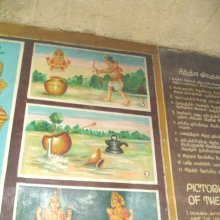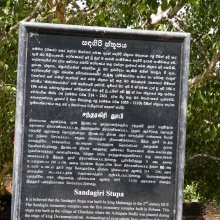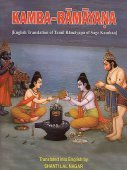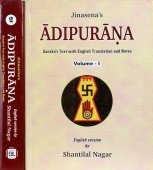Adi, Ādi, Āḍi: 27 definitions
Introduction:
Adi means something in Hinduism, Sanskrit, Jainism, Prakrit, Buddhism, Pali, the history of ancient India, Marathi, Hindi, biology. If you want to know the exact meaning, history, etymology or English translation of this term then check out the descriptions on this page. Add your comment or reference to a book if you want to contribute to this summary article.
Alternative spellings of this word include Aadi.
Images (photo gallery)
(+26 more images available)
In Hinduism
Purana and Itihasa (epic history)
Source: archive.org: Puranic EncyclopediaĀḍi (आडि).—A mighty son of the demon, Andhakāsura. He did penance to please Brahmā and obtained from him a boon to seek vengeance on Śiva who had murdered his father. The boon was that Āḍi would die only when he left his present form and took another form. After obtaining the boon Āḍi went to Kailāsa and outwitting the sentries entered the abode of Śiva in the shape of a serpent. After that he disguised himself as Pārvatī and went near Śiva. But Śiva knew the trick and killed him. (Sṛṣṭi Khaṇḍa of Padma Purāṇa).
Source: Cologne Digital Sanskrit Dictionaries: The Purana IndexĀḍi (आडि).—A son of Asura Andhaka; to wreak vengeance on śiva for having slain his father, he entered the harem of Śiva in the guise of a snake, and assumed the guise of Umā before him. He could change his form twice as he liked owing to a boon from Brahmā; but the second change would be followed by death. On close examination, Śiva discovered the figure to be the Asura in disguise, threw the Vajra and slew him.*
- * Matsya-purāṇa 156. 12-37.

The Purana (पुराण, purāṇas) refers to Sanskrit literature preserving ancient India’s vast cultural history, including historical legends, religious ceremonies, various arts and sciences. The eighteen mahapuranas total over 400,000 shlokas (metrical couplets) and date to at least several centuries BCE.
Vyakarana (Sanskrit grammar)
Source: Wikisource: A dictionary of Sanskrit grammarAdi (अदि).—Uṇādi affix अदि (adi) e. g, शरद्, दरद् (śarad, darad); cf. शॄदॄभसो (śṝdṝbhaso)sदि (di); Uṇādi-sūtra 127;
--- OR ---
1) Ādi (आदि).—Commencement, initial: cf. अपूर्वलक्षण आदिः (apūrvalakṣaṇa ādiḥ) M.Bh. on I.1.21,
2) Ādi.—Of the kind of, similar; एवंप्रक्रारः (evaṃprakrāraḥ).

Vyakarana (व्याकरण, vyākaraṇa) refers to Sanskrit grammar and represents one of the six additional sciences (vedanga) to be studied along with the Vedas. Vyakarana concerns itself with the rules of Sanskrit grammar and linguistic analysis in order to establish the correct context of words and sentences.
Vaishnavism (Vaishava dharma)
Source: Pure Bhakti: Bhagavad-gita (4th edition)Ādi (आदि) refers to “beginning, first”. (cf. Glossary page from Śrīmad-Bhagavad-Gītā).

Vaishnava (वैष्णव, vaiṣṇava) or vaishnavism (vaiṣṇavism) represents a tradition of Hinduism worshipping Vishnu as the supreme Lord. Similar to the Shaktism and Shaivism traditions, Vaishnavism also developed as an individual movement, famous for its exposition of the dashavatara (‘ten avatars of Vishnu’).
Jyotisha (astronomy and astrology)
Source: Wisdom Library: Brihat Samhita by VarahamihiraĀdi (आदि) or Ādikāla refers to the “commencement of the eclipses”, according to the Bṛhatsaṃhitā (chapter 2), an encyclopedic Sanskrit work written by Varāhamihira mainly focusing on the science of ancient Indian astronomy astronomy (Jyotiṣa).—Accordingly, “We shall now proceed to give a brief description of (the qualifications of) a jyotiṣaka. [...] In solar and lunar eclipses, he must be able to calculate the times of the commencement and end of the eclipses [i.e., ādi-kāla], the places of first and last contact, the magnitude and duration of the eclipse; in total eclipses, he must be able to calculate the time between middle eclipse and the beginning or end of total phase, (this period being technically known as vimarda). He must also know the colour of the eclipsed lunar disc. He must be able to calculate before hand the times of the Moon’s conjunction with the planets as well as of planetary conjunctions”.

Jyotisha (ज्योतिष, jyotiṣa or jyotish) refers to ‘astronomy’ or “Vedic astrology” and represents the fifth of the six Vedangas (additional sciences to be studied along with the Vedas). Jyotisha concerns itself with the study and prediction of the movements of celestial bodies, in order to calculate the auspicious time for rituals and ceremonies.
Ganitashastra (Mathematics and Algebra)
Source: archive.org: Hindu MathematicsĀdi (आदि) represents the number 1 (one) in the “word-numeral system” (bhūtasaṃkhyā), which was used in Sanskrit texts dealing with astronomy, mathematics, metrics, as well as in the dates of inscriptions and manuscripts in ancient Indian literature.—A system of expressing numbers by means of words arranged as in the place-value notation was developed and perfected in India in the early centuries of the Christian era. In this system the numerals [e.g., 1—ādi] are expressed by names of things, beings or concepts, which, naturally or in accordance with the teaching of the Śāstras, connote numbers.
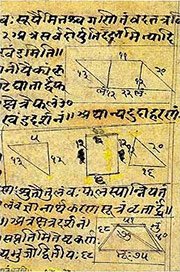
Ganitashastra (शिल्पशास्त्र, gaṇitaśāstra) refers to the ancient Indian science of mathematics, algebra, number theory, arithmetic, etc. Closely allied with astronomy, both were commonly taught and studied in universities, even since the 1st millennium BCE. Ganita-shastra also includes ritualistic math-books such as the Shulba-sutras.
In Jainism
General definition (in Jainism)
Source: SOAS Research Online: Prekṣā meditation: History and MethodsĀdi (आदि) refers to “beginning”; as opposed to Anādi—“beginningless” which refers to one of the 46 qualities of the soul to be meditated on in the “Practice of Meditation on Liberated Souls (Siddhas)”, according to Jain texts like Ācārāṅga (5.6.123-140), Ṣaṭkhaṇḍāgama (13.5.4.31) and Samayasāra (1.49).—The pure soul can be recognised by meditation on its true nature, represented by the liberated souls of the Siddhas. [...] The qualities of the soul to be meditated on as truly mine are: [e.g., My soul is beginning-less (an-ādi)] [...] The meditation on such extended fourty-five qualities of the pure soul presents the niśacaya-naya, which is aligned with Kundakunda’s approach.

Jainism is an Indian religion of Dharma whose doctrine revolves around harmlessness (ahimsa) towards every living being. The two major branches (Digambara and Svetambara) of Jainism stimulate self-control (or, shramana, ‘self-reliance’) and spiritual development through a path of peace for the soul to progess to the ultimate goal.
India history and geography
Source: Cologne Digital Sanskrit Dictionaries: Indian Epigraphical GlossaryĀdi.—(IE 7-1-2), ‘one’. Note: ādi is defined in the “Indian epigraphical glossary” as it can be found on ancient inscriptions commonly written in Sanskrit, Prakrit or Dravidian languages.

The history of India traces the identification of countries, villages, towns and other regions of India, as well as mythology, zoology, royal dynasties, rulers, tribes, local festivities and traditions and regional languages. Ancient India enjoyed religious freedom and encourages the path of Dharma, a concept common to Buddhism, Hinduism, and Jainism.
Biology (plants and animals)
Source: Wisdom Library: Local Names of Plants and DrugsAdi in the Urdu language is the name of a plant identified with Zingiber officinale Roscoe from the Zingiberaceae (Ginger) family. For the possible medicinal usage of adi, you can check this page for potential sources and references, although be aware that any some or none of the side-effects may not be mentioned here, wether they be harmful or beneficial to health.
Source: Google Books: CRC World Dictionary (Regional names)1) Adi in India is the name of a plant defined with Zingiber officinale in various botanical sources. This page contains potential references in Ayurveda, modern medicine, and other folk traditions or local practices It has the synonym Amomum zinziba Hill (among others).
2) Adi in Nigeria is also identified with Garcinia kola.
Example references for further research on medicinal uses or toxicity (see latin names for full list):
· Cytologia (1985)
· Zingiberoideae.
· Bull. Bot. Survey India (1972)
· Journal de Pharmacie et de Chimie (1883)
· Plantas que curam e cortam feitiços. (1988)
· Cytologia (1998)
If you are looking for specific details regarding Adi, for example health benefits, chemical composition, pregnancy safety, diet and recipes, side effects, extract dosage, have a look at these references.

This sections includes definitions from the five kingdoms of living things: Animals, Plants, Fungi, Protists and Monera. It will include both the official binomial nomenclature (scientific names usually in Latin) as well as regional spellings and variants.
Languages of India and abroad
Pali-English dictionary
Source: BuddhaSasana: Concise Pali-English Dictionaryadi : (aor. of adati) ate. || ādi (m.), starting point; beginning. (adj.), first; beginning with. (nt.), and so on; so forth.
Source: Sutta: The Pali Text Society's Pali-English DictionaryĀdi, (Sk. ādi, etym. uncertain) — 1. (m.) starting-point, beginning Sn.358 (Acc. ādiṃ = kāraṇaṃ SnA 351); Dh.375 (Nom. ādi); Miln.10 (ādimhi); J.VI, 567 (Abl. ādito from the beginning). For use as nt. see below 2 b. — 2. (adj. & adv.) (a) (°-) beginning, initially, first, principal, chief: see cpds. — (b) (°-) beginning with, being the first (of a series which either is supposed to be familiar in its constituents to the reader or hearer or is immediately intelligible from the context), i. e. and so on, so forth (cp. adhika); e. g. rukkha-gumb-ādayo (Acc. pl.) trees, jungle etc. J.I, 150; amba-panas’ādīhi rukkehi sampanno (and similar kinds of fruit) J.I, 278; amba-labuj’ādīnaṃ phalānaṃ anto J.II, 159; asi-satti-dhami-ādīni āvudhāni (weapous, such as sword, knife, bow & the like) J.I, 150; kasi-gorakkh’ādīni karonte manusse J.II, 128; . . . ti ādinā nayena in this and similar ways J.I, 81; PvA.30. Absolute as nt. pl. ādinī with ti (evaṃ) (ādīni), closing a quotation, meaning “this and such like”, e. g. at J.II, 128, 416 (ti ādīni viravitvā). — In phrase ādiṃ katvā meaning “putting (him, her, it) first”, i. e. heginning with, from . . . on, from . . . down (c. Acc.) e. g. DhA.I, 393 (rājānaṃ ādiṃ K. from the king down); PvA.20 (vihāraṃ ādikatvā), 21 (pañcavaggiye ādiṃ K.).

Pali is the language of the Tipiṭaka, which is the sacred canon of Theravāda Buddhism and contains much of the Buddha’s speech. Closeley related to Sanskrit, both languages are used interchangeably between religions.
Marathi-English dictionary
Source: DDSA: The Molesworth Marathi and English Dictionaryaḍī (अडी).—f (Commonly aḍhī) A layer of fruits on a bed of straw (to be ripened). 2 The basin of a thrashing floor. 3 Sometimes used in the other senses of aḍhī.
--- OR ---
āḍī (आडी).—f (āḍi S) A bird, Turdus ginginianus.
--- OR ---
āḍī (आडी).—f C A common term for the bars of a waterwheel. 2 Framework to confine a vitious cow during milking. 3 The intertwined state of the feet of wrestlers. 4 Commonly aḍhī esp. in Sig. I.
--- OR ---
ādi (आदि).—m (S) Source, stock, root, origin; the seat or subject sustaining, or the cause or principle originating. 2 The beginning, commencement, first part. 3 The first term of a series.
--- OR ---
ādi (आदि).—a (S) First, prior, principal, chief. 2 In comp. although the meaning is still this, First or principal, it well corresponds with Et cetera: as indrādi dēva Indra and the other gods, i. e. Indra being first, the gods; rambhādi-striyā, kāmakrōdha- lōbhādi &c. As the medial member of a compound it assumes ka and becomes ādika, as akārādikavarṇa; brāhmaṇādika jāti; ākāśādika bhūtēṃ. The alphabet from अ; the castes from the Brahman; the five elements from ākāśa. 3 It forms compounds such as ādikāla, ādikāvya, ādidēva, ādidharma, ādibhāṣā, ādisampradāya &c. Others occur in order.
Source: DDSA: The Aryabhusan school dictionary, Marathi-Englishaḍī (अडी).—f A layer of fruits on a bed of straw.
--- OR ---
āḍī (आडी).—f Bars of a waterwheel. Frame- work to control a vicious cow while milking. The intertwined position of the feet of wrestlers. A kind of bird.
--- OR ---
ādi (आदि).—m Source; the beginning. a Prior, chief &c. In compounds it corres- ponds to et cetera. indrādi dēva Indra and the other gods. As the intermedi- ate part of a compound ādi becomes ādika as indrādika dēva, ākāśādika bhūtēṃ.
Marathi is an Indo-European language having over 70 million native speakers people in (predominantly) Maharashtra India. Marathi, like many other Indo-Aryan languages, evolved from early forms of Prakrit, which itself is a subset of Sanskrit, one of the most ancient languages of the world.
Sanskrit dictionary
Source: DDSA: The practical Sanskrit-English dictionaryĀḍi (आडि).—= आटि (āṭi) q. v.
Derivable forms: āḍiḥ (आडिः).
--- OR ---
Ādi (आदि).—a.
1) First, primary, primitive; निदानं त्वादिकारणम् (nidānaṃ tvādikāraṇam) Ak.
2) Chief, first, principal, pre-eminent; oft. at the end of comp. in this sense; see below.
3) First in time existing before.
-dīḥ 1 Beginning, commencement (opp. anta); अप एव ससर्जादौ तासु बीजमवासृजत् (apa eva sasarjādau tāsu bījamavāsṛjat) Manusmṛti 1.8; Bhagavadgītā (Bombay) 3.41; अनादि (anādi) &c.; जगदादिरनादिस्त्वम् (jagadādiranādistvam) Kumārasambhava 2.9; oft. at the end of comp. and translated by 'beginning with', 'et cætera', 'and others', 'and so on' (of the same nature or kind), 'such like'; इन्द्रादयो देवाः (indrādayo devāḥ) the gods Indra and others (indraḥ ādiryeṣāṃ te); एवमादि (evamādi) this and the like; भ्वादयो धातवः भू (bhvādayo dhātavaḥ bhū) and others, or words beginning with भू (bhū), are called roots; oft. used by Pāṇini to denote classes or groups of grammatical words; अदादि, दिवादि, स्वादि (adādi, divādi, svādi) &c.
2) First part of portion.
3) A firstling, first-fruits.
4) Prime cause.
5) Nearness.
6) One of the seven parts of Sāma; अथ सप्तविधस्य वाचि सप्तविधं सामोपासीत यत्किंच वाचो हुमिति स हिंकारो यत्प्रेति स प्रस्तावो यदेति स आदिः (atha saptavidhasya vāci saptavidhaṃ sāmopāsīta yatkiṃca vāco humiti sa hiṃkāro yatpreti sa prastāvo yadeti sa ādiḥ) Ch. Up.2.8.1.
Source: Cologne Digital Sanskrit Dictionaries: Edgerton Buddhist Hybrid Sanskrit DictionaryĀdi (आदि).—beginning (= Sanskrit): ādiṃ, acc. (= Pali ādiṃ katvā, with acc. object) and ādau, loc., with following kṛtvā, and preceding acc. (once gen.), lit. putting…first; so beginning with, starting with, from…on (the loc. ādau used precisely like the acc. ādiṃ; putting at the beginning = making the beginning; loc. only in Mahāvastu): tuṣitabhavanavāsam ādiṃ kṛtvā, beginning with (the Bodhisattva's) dwelling in the Tuṣita-heaven (= from then on) Śikṣāsamuccaya 292.5 = Daśabhūmikasūtra 14.21, compare tuṣitabhavanam ādau kṛtvā sarveṣāṃ bodhi- sattvānāṃ…Mahāvastu i.147.15; āvīcim ādiṃ kṛtvā sarvanai- rayikāṇāṃ sattvānāṃ…Lalitavistara 86.11, of all hell-inhabitants [Page093-b+ 71] from Āvīci on; mātuḥ kukṣim ādau kṛtvā bodhisattvānāṃ yāvat parinirvṛtā Mahāvastu i.145.2, beginning with the mother's womb, of Bodhisattvas, until they have entered complete nirvāṇa; bhartāraṃ ādau kṛtvā Mahāvastu i.147.8 (no man has any carnal desire for the destined mothers of Buddhas) from their husbands on; bodhisattvasya garbhāvakrāntim ādau kṛtvā Mahāvastu i.157.15; śākyamuniṃ samyaksaṃbuddhaṃ ādau kṛtvā ḍaśa bhūmayo deśitā Mahāvastu i.161.7, beginning from (the time of) Śākyamuni the Buddha, the Ten Stages have been taught (not before! so, I think, the parallels require us to interpret, contrary to Senart n. 506); with gen. of the dependent noun (rather than acc.), evidently construed as modifier of ādiṃ: tṛṣṇāyāḥ paunarbhavikyā ādiṃ kṛtvā Laṅkāvatāra-sūtra 180.10, beginning with (starting from; lit. making a beginning of) desire for rebirth. Cf. Mahābhārata Crit. ed. 2.52.17d saha strībhir draupadīm ādi-kṛtvā, along with the women, beginning with Draupadī (i.e. D. and the others). This seems to be unparalleled in Sanskrit See also s.v. ādīkaroti.
Source: Cologne Digital Sanskrit Dictionaries: Shabda-Sagara Sanskrit-English DictionaryĀḍi (आडि).—f.
(-ḍiḥ) A bird, the S'arali, (Turdus ginginianus.) E. āṅ before aḍa to go, in affix; also āṭi, āḍikā and āṭī.
--- OR ---
Ādi (आदि).—m. only
(-diḥ) 1. First, prior. 2. First, pre-eminent. ind. (In composition,) Other, et-cetera, as svādi the affix su et-cetera. E. āṅ before dā to give, and ki aff.
Source: Cologne Digital Sanskrit Dictionaries: Benfey Sanskrit-English DictionaryĀdi (आदि).—i. e. ādya, with i for ya, 1. m. Beginning, [Mānavadharmaśāstra] 1, 8; 4, 25. 2. indecl. First, Mahābhārata 2, 2008.
Source: Cologne Digital Sanskrit Dictionaries: Cappeller Sanskrit-English DictionaryĀdi (आदि).—[masculine] commencement, beginning, firstling; [locative] ādau in the beginning, first. Often adj. —° (also ādika) beginning with, and so on. Abstr. āditva & ādikatva [neuter]
Source: Cologne Digital Sanskrit Dictionaries: Monier-Williams Sanskrit-English Dictionary1) Āḍi (आडि):—f. (= āti q.v.) Name of an aquatic bird, [Mārkaṇḍeya-purāṇa]
2) Āḍī (आडी):—[from āḍi] f. = āḍi q.v.
3) Ādi (आदि):—1. ādi m. beginning, commencement
4) a firstling, first-fruits
5) ifc. beginning with, et caetera, and so on (e.g. indrādayaḥ surāḥ, the gods beginning with Indra id est. Indra etc.; gṛhādiyukta, possessed of houses etc.; evamādīni vastūni, such things and others of the same kind: śayyā khaṭvādiḥ [Comm. on [Pāṇini 3-3, 99]], Śayyā means a bed etc.; often with -ka at the end e.g. dānadharmādikam [Hitopadeśa], liberality, justice, etc.)
6) the third part in the 7-partite Sāman, [Chāndogya-upaniṣad]
7) 2. ādi mfn. beginning with ā, [Rāmatāpanīya-upaniṣad]
8) Ādī (आदी):—[=ā-dī] -√2. dī (3. sg. [imperfect tense] ādīdet, [Ṛg-veda i, 149, 3]; 3. sg. [Aorist] ā-dīdayat, [Ṛg-veda ii, 4, 3]) to shine upon, enlighten.
Source: Cologne Digital Sanskrit Dictionaries: Yates Sanskrit-English Dictionary1) Āḍi (आडि):—(ḍiḥ) 2. f. A bird, vide āṭi.
2) Ādi (आदि):—(diḥ) 2. m. Beginning (in composition, et cetera.)
Source: DDSA: Paia-sadda-mahannavo; a comprehensive Prakrit Hindi dictionary (S)Ādi (आदि) in the Sanskrit language is related to the Prakrit words: Āi, Ādī.
[Sanskrit to German]
Sanskrit, also spelled संस्कृतम् (saṃskṛtam), is an ancient language of India commonly seen as the grandmother of the Indo-European language family (even English!). Closely allied with Prakrit and Pali, Sanskrit is more exhaustive in both grammar and terms and has the most extensive collection of literature in the world, greatly surpassing its sister-languages Greek and Latin.
Hindi dictionary
Source: DDSA: A practical Hindi-English dictionary1) Ādi (आदि) [Also spelled aadi]:—(nm) beginning; (ind) etcetera; (a) early, initial, primordial; ~[kavi] the first-ever poet — Valmiki, the author of Sanskrit Ramayan; ~[kālīna] primitive; ~[kāvya] the Ramayan of Valmiki —the first literary creation; —[puruṣa] Brahma: —the creator of the Universe; ~[rūpa] prototype.
2) Ādī (आदी) [Also spelled aadi]:—(a) habitual; habituated, accustomed.
...
Prakrit-English dictionary
Source: DDSA: Paia-sadda-mahannavo; a comprehensive Prakrit Hindi dictionary1) Āḍi (आडि) in the Prakrit language is related to the Sanskrit word: Āṭi.
2) Ādī (आदी) also relates to the Sanskrit word: Ādī.
Prakrit is an ancient language closely associated with both Pali and Sanskrit. Jain literature is often composed in this language or sub-dialects, such as the Agamas and their commentaries which are written in Ardhamagadhi and Maharashtri Prakrit. The earliest extant texts can be dated to as early as the 4th century BCE although core portions might be older.
Kannada-English dictionary
Source: Alar: Kannada-English corpusAḍi (ಅಡಿ):—
1) [noun] that part of the animal body on which it normally stands or walks; the foot.
2) [noun] that part of the body from the hips to the toe; the leg.
3) [noun] a unit of measure of length; a distance of twelve inches; a foot.
4) [noun] a honorific suffix to the names of the elders or teachers or used as a part of names.
5) [noun] a member of a particular Brāhmaṇa caste.
6) [noun] the lowest portion of anything; a place or room below.
7) [noun] a fact, scheme, purpose, method etc. kept undivulged; a secret.
8) [noun] that which supports or shelters.
9) [noun] the prime cause.
10) [noun] an account of measure, quantity, value, etc.
11) [noun] a line of poetry; a foot.
12) [noun] the ground meant for or occupied by, a building; a site.
13) [noun] an iron or steel block on which metal objects are hammered into shape; an anvil;14) [noun] ಅಡಿಗಡಿಗೆ [adigadige] aḍigaḍige (fig.) frequently; very often; now and then; ಅಡಿಗಿಕ್ಕು [adigikku] aḍigikku to trample under the foot; to tread upon; 2. to spoil by walking on; ಅಡಿಯಾಱರ ಪಕ್ಕಿ [adiyarara pakki] aḍiyāṛ ara pakki the bee, which has six legs; ಅಡಿಯಿಡು [adiyidu] aḍiyiḍu to move by executing forward, backward, etc. by executing steps. 2) to stamp (something) with a foot; ಅಡಿಜಾರಿ ಬಿದ್ದರೂ ಬಡಿವಾರ ಬಿಡಲಿಲ್ಲ [adijari biddaru badivara bidalilla]/ ಅಡಿಗೆ ಬಿದ್ದರೂ ಮೀಸೆ ವ [adige biddaru mise va]iಣ್ಣಾಗಲಿಲ್ಲ ಎನ್ನು [nnagalilla ennu] aḍi jāri biddarū baḍivāra biḍalilla/ aḍige biddarū mīse maṇṇāgalilla ennu (prov.) to boast of oneself even when dignity is lost.
--- OR ---
Aḍi (ಅಡಿ):—
1) [noun] act of opposing; opposition.
2) [noun] that which opposes or impedes; an obstacle.
3) [noun] a difficult situation.
--- OR ---
Āḍi (ಆಡಿ):—[noun] a kind of bird, Turdus ginginianus.
--- OR ---
Āḍi (ಆಡಿ):—[noun] āṣāḍha, the fourth month of the solar calendar followed in some parts of India.
--- OR ---
Ādi (ಆದಿ):—
1) [adjective] (used as adj. usu. in compositions) being, happening, happened, first; primary; primitive.
2) [adjective] first in time; existing before.
--- OR ---
Ādi (ಆದಿ):—
1) [noun] a starting or commencing; a beginning; commencement.
2) [noun] first part or portion.
3) [noun] the prime or fundamental cause.
4) [noun] the early age in the history (of the universe, human race, etc.).
5) [noun] (mus.) a bond of rhythmic cycle with eight units of two or four short notes each.
6) [noun] (gram.) the case in which the subject is expressed; the nominative case, the first of the nine cases.
Kannada is a Dravidian language (as opposed to the Indo-European language family) mainly spoken in the southwestern region of India.
See also (Relevant definitions)
Starts with (+1124): A-tintukurri, Aadi pooram, Aadigranth, Aadikiran, Adhivedana, Adi Buddha, Adi Kumbeswarar, Adi-hunu, Adi-kkashu, Adi-marsang, Adi-mudra, Adi-ppaccai, Adiama, Adiamba, Adiamdhra, Adianta, Adiantum aethiopicum, Adiantum capillus-veneris, Adiantum caudatum, Adiantum chilense.
Ends with (+4582): A-campirannatacamati, Aadi, Aakasmiktavaadi, Aanathottavadi, Abadi, Abhayadi, Abhedavadi, Abhidadi, Abhihitanvayavadi, Abhinadi, Abhipadi, Abhisamdadi, Abhivyaktivadi, Abhrakadi, Abhrakagandhakadi, Abhranadi, Abhutavadi, Acaiyati, Acammati, Acankati.
Full-text (+2796): Adim, Adibaka, Adima, Anadi, Adiraja, Adiprabhriti, Adika, Adikaroti, Adikavi, Adikala, Adivamsha, Adikara, Adiyogacarya, Adipurusha, Aditas, Adijina, Aditala, Cakrapaleya, Adideva, Adi-ppaccai.
Relevant text
Search found 165 books and stories containing Adi, A-di, Ā-dī, Ādi, Āḍi, Aḍī, Āḍī, Ādī, Aḍi; (plurals include: Adis, dis, dīs, Ādis, Āḍis, Aḍīs, Āḍīs, Ādīs, Aḍis). You can also click to the full overview containing English textual excerpts. Below are direct links for the most relevant articles:
Chandogya Upanishad (Madhva commentary) (by Srisa Chandra Vasu)
Second Adhyaya, Eighth Khanda (3 mantras)
Second Adhyaya, Tenth Khanda (5 mantras)
Sahitya-kaumudi by Baladeva Vidyabhushana (by Gaurapada Dāsa)
Text 4.6 < [Chapter 4 - First-rate Poetry]
Text 4.78 < [Chapter 4 - First-rate Poetry]
Text 4.8 < [Chapter 4 - First-rate Poetry]
Puranic encyclopaedia (by Vettam Mani)
Mandukya Upanishad (Madhva commentary) (by Srisa Chandra Vasu)
Mantra 3.2 < [Chapter 3 - Third Khanda]
Karika verse 3.5 < [Chapter 3 - Third Khanda]
Karika verse 3.9 < [Chapter 3 - Third Khanda]
Bhakti-rasamrta-sindhu (by Śrīla Rūpa Gosvāmī)
Verse 4.3.40 < [Part 3 - Chivalry (vīrya-rasa)]
Verse 1.2.218 < [Part 2 - Devotional Service in Practice (sādhana-bhakti)]
Verse 1.2.231 < [Part 2 - Devotional Service in Practice (sādhana-bhakti)]
The Devi Bhagavata Purana (by Swami Vijñanananda)
Related products



